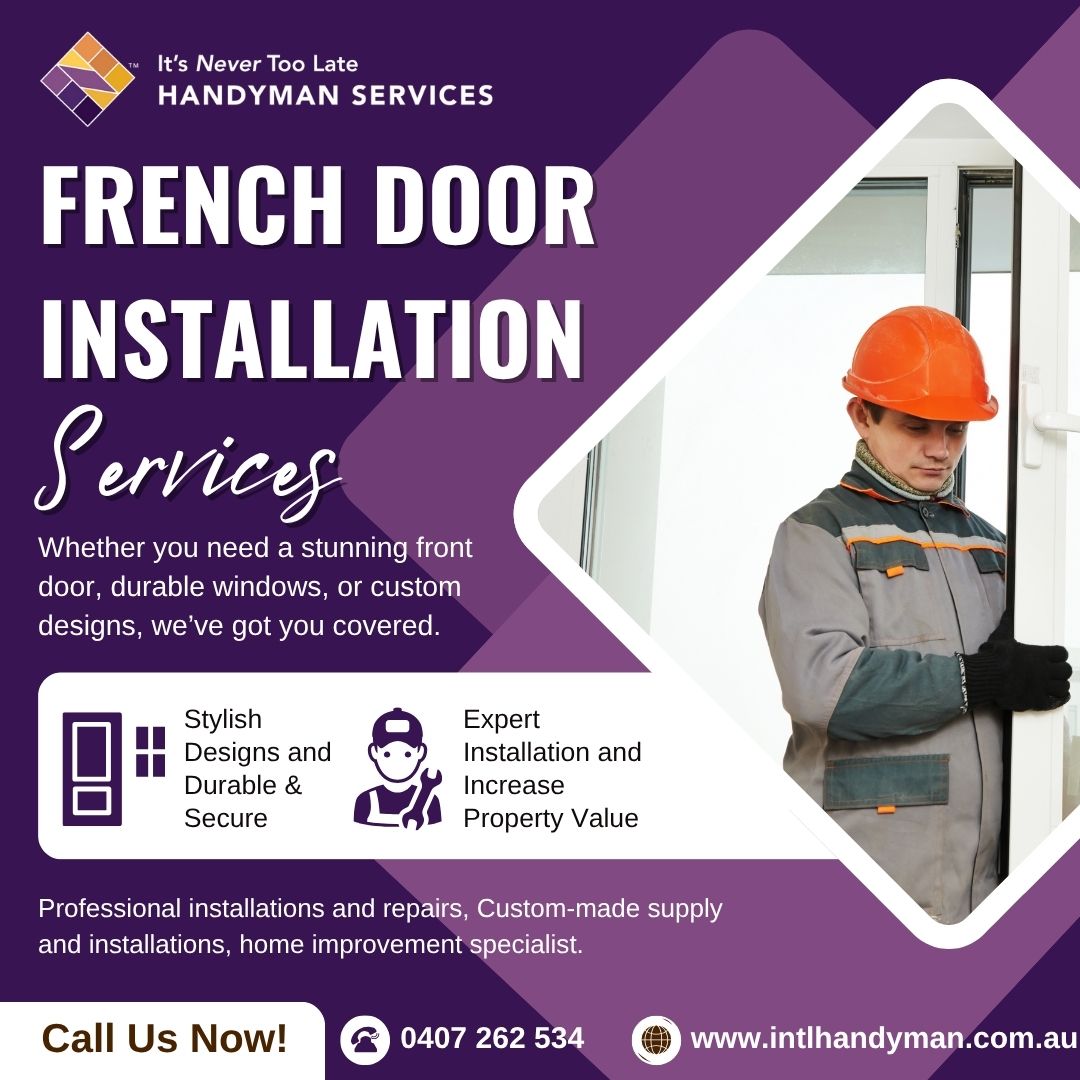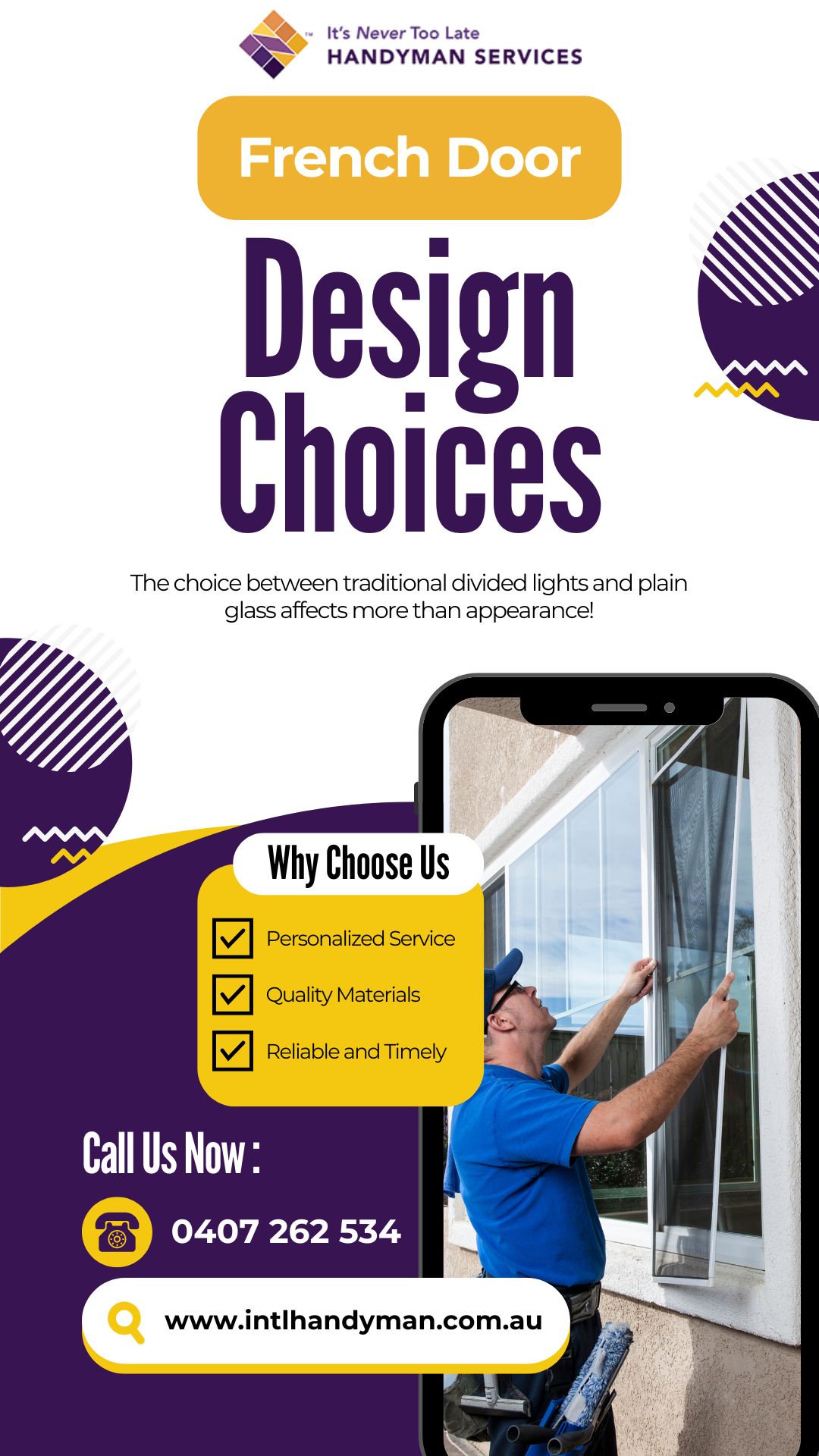ITS NEVER TOO LATE HANDYMAN SERVICE
The Complete Guide to French Doors: Professional Insights on Selection, Installation, and Finishing
After ten years installing doors across Sydney Australia, I’ve learned that the difference between a door that lasts three years and one that lasts over ten isn’t luck-it’s understanding what most contractors, get fundamentally wrong.
I’ve seen $5,000 installations fail within 18 months because corners were cut on wood selection. I’ve watched beautiful doors warp and leak because the painting process was rushed. Most frustrating of all, I’ve replaced “bargain” installations where homeowners ended up paying twice—once for the cheap job, and then again to do it properly.
This guide contains the professional insights that separate lasting installations from expensive mistakes. By the end, you’ll know exactly what questions to ask any contractor and why most quotes you receive will reveal critical gaps in their process.
Why Wood Selection Determines Everything
Here’s what most people don’t realize: French doors are only as good as their weakest component, and that’s almost always the wood choice. When I quote a job, the first thing I assess isn’t the opening size—it’s which direction the door faces.
North-facing doors absorb the most sunlight, causing microscopic cracks that develop into paint peeling and moisture infiltration. East and west-facing doors struggle with insufficient drying time between rain events, causing wood fibres to retain moisture. South-facing doors have the best protection, but even they’re vulnerable without proper material selection and installation.
Alaskan Yellow Cedar: The Professional’s Choice
When clients ask what woods I recommend, the answer is always Alaskan Yellow Cedar. Here’s why:
- Natural resistance: Contains oils that repel insects and resist rot
- Closed grain structure: Absorbs less moisture than alternatives
- Stability: Handles weight and weather without deforming
- Proven performance: Used in boat building and marine applications, worldwide
Yellow Cedar costs more upfront, but it’s the difference between repainting every 3-4 years versus every 7-10 years. For a quality-focused homeowner, this isn’t even a decision.
When Yellow Cedar Isn’t Available
If supply is an issue, these alternatives can work with proper treatment:
Silver Ash: Hardwood suitable for fire-prone areas, but requires more frequent maintenance Victorian Ash: Strong and stable, excellent for protected locations Light Red Meranti: Open grain requiring extra sealing attention
The key difference? Yellow Cedar forgives minor application errors. These alternatives don’t.
Professional Insight: Any contractor who doesn’t discuss wood grain structure or directional exposure isn’t thinking long-term about your installation.



Design Choices That Impact Performance
Classic Grid vs. Plain Glass: More Than Aesthetics
The choice between traditional divided lights and plain glass affects more than appearance:
Grid Pattern Doors:
- Provide stunning morning light patterns (especially north-facing)
- Require ongoing maintenance of wood mullions
- Cost more initially and in long-term upkeep
- Offer better security (harder to break large glass areas)
Plain Glass Doors:
- Maximize unobstructed views
- Easier to clean and maintain
- Less expensive initially
- Better for modern architectural styles
Professional Recommendation: If you’re choosing grids, you can invest in engineered wood mullions for the interior face. They maintain the look while reducing maintenance, though they do paint slightly glossier than natural timber and can retain heat.
Installation Precision That Prevents Problems
Most French door failures happen at the details other contractors overlook. Here’s what separates professional installation:
The Critical Measurement Process
Every replacement door needs a detailed drawing with exact specifications. I treat each job like a custom build because that’s exactly what it is. Using existing openings without verification is like filming a movie without a script—it might work but will it really?
Hardware Selection That Lasts
Lock Back set Requirements:
- 35mm doors: 45mm back set mortised lock
- 40mm doors: 50mm back set mortised lock
Hinge Strategy: I install three hinges per door, regardless of weight. This distributes load evenly and prevents sagging over time. Most contractors use two hinges to save money—and create future problems.
Handle Installation: Secured firmly but not overtightened. Gaps around hardware get sealed with transparent silicone, applied as a thin bead.
Inward vs. Outward Opening
Outward opening is generally preferred because:
- Doesn’t consume interior space
- Won’t hit appliances or furniture
- Better weather sealing potential
Inward opening may be necessary due to:
- Limited exterior space (small verandas)
- Obstruction from landscaping
- Local building requirements
Critical Point: Ensure your lock selection matches your opening direction and hand (left/right). This seems basic, but I’ve seen it missed surprisingly often when the latter could have been used.

The Professional Painting Process
Here’s where I see the biggest gaps between contractors. Most apply 2-3 coats and consider the job done. My process involves 5-7 strategic applications, and here’s why that difference saves thousands in future maintenance.
Why Oil-Based Paints Still Win
Despite advances in water-based technology, oil-based paints remain superior for exterior doors:
- Better adhesion: Forms stronger bonds with wood fibres
- Moisture resistance: Less water content means harder, more durable finish
- Fewer coats needed: Builds thickness more efficiently than water-based alternatives
Water-based paints have improved significantly but require more coats to achieve equivalent protection. For French doors exposed to weather, oil-based remains the professional standard.
The Thin-Coat Methodology
First coat application: Applied extremely thin to begin the sealing process. Thick first coats risk flaking as UV exposure causes thermal expansion and contraction.
Drying time: Minimum 2-3 hours between coats in ideal conditions (24-29°C). Always paint in shade to prevent surface skinning while the interior remains wet.
Sanding between coats: 320-grit sandpaper provides perfect surface preparation without removing excessive material. Coarser grits are tempting but compromise the build-up process.
Special Attention Areas
Trimmed edges are where most moisture infiltration begins. These areas require 4-6 light coats because:
- End grain absorbs more moisture
- Cut edges bypass factory sealing
- Standard 2-3 coat applications are insufficient
Hardware cutouts need careful sealing around locks, handles, and hinges. Any gaps get sealed with transparent silicone after installation.
Temperature and Timing Considerations
Perfect painting conditions are rare, but the process will never be rushed. In less-than-ideal weather, extend drying times and reduce coat thickness. A properly applied finish in challenging conditions outperforms a rushed job in perfect weather.
Environmental Protection Strategies
The Awning Advantage
When quoting jobs, I always discuss installing an awning too. It’s the single most effective addition to extend door life by:
- Redirecting rainfall away from the door surface
- Reducing UV exposure during peak sun hours
- Reducing moisture absorbance between weather events
Not every home suit an awning, but when feasible, it’s a worthwhile investment that pays dividends in reduced door maintenance.
Directional Considerations
North-facing installations need maximum UV protection through:
- Additional paint coats
- Higher-quality primers and paints
- More frequent inspection schedules
East/West installations require attention to moisture management through:
- Enhanced sealing of all joints
- Proper drainage design
- Ventilation considerations
The True Cost of Quality
Aluminium doors might seem like a low-maintenance alternative, but they create problems many homeowners don’t anticipate:
- Thermal bridging: Metal conducts cold directly into your home
- Expansion gaps: Required tolerances allowing air infiltration
- Limited customization: Fewer colour and style options
- Higher installation costs: Especially for large or complex openings
Wooden doors, properly installed and maintained, offer superior insulation, unlimited customization options, and often lower total cost of ownership.
Red Flags in Contractor Quotes
After reviewing some of competitor quotes over the years, here are the warning signs:
- No mention of wood species: If they’re not discussing grain structure and moisture resistance, they’re not thinking professionally
- Minimal paint specifications: “Two coats of exterior paint” isn’t a professional specification
- No directional assessment: Orientation affects every other decision
- Lower pricing: Quality materials and proper process have real costs
- Rushed timeline: Proper installation and finishing can’t be rushed
Making the Right Choice
The difference between a successful French door installation and an expensive mistake isn’t just about finding a good contractor—it’s about finding one who understands that every detail matters. Remember, you are paying for the solution.
Quality-focused homeowners recognize that paying appropriately for expertise prevents the frustration and expense of dealing with premature failure. When you’re investing in French doors, you’re making a 20-year decision. Make sure your contractor is thinking the same way.
The right professional will discuss wood species, assess your home’s orientation, specify their painting process in detail, and provide references for similar work. They’ll also be transparent about timeline requirements because they understand that rushing quality work serves nobody well.
Your French doors should enhance your home’s beauty and functionality for decades. With proper material selection, precision installation, and professional finishing, they will.
Call Eugene: 0407 262 534
to discuss new French Door Installation or Replacement.
“Schedule Your Professional Consultation” Investment in quality starts with expert assessment!
Why Homeowners Choose Our Installation Service
Licensed & Fully Insured – Your investment is protected every step of the way
Premium Supplier Partnership – Access to door systems not available through big box stores
100+ Successful Installations – Proven track record with complex and custom projects
Average Project Completion: 7-14 Days – Professional efficiency from start to finish
3-Year Installation Warranty – Standing behind our craftsmanship long-term
If you have any other problems with any of the doors, the installation, I answer my phone and make you a priority in providing a solution.
Frequently Asked Questions
Why do you charge for consultations?
“Professional assessment can take 2-3 hours of focused expertise – site evaluation, material recommendations, and project drawing planning on site. This investment ensures you receive accurate pricing and realistic timelines, not rushed estimates or ballpark figures. The consultation fee is applied towards your project cost when you move forward.”
Should I get a detailed quote?
Yes, you should. In writing what you will receive in materials, labour and process, originally discussed. It should also include delivery, installation quirks, warranty and what you will not receive, as part of the quote and payment terms and any explicit terms and conditions that will help you make an educated decision to proceed.
Can I further weatherproof my French Doors, after installation?
Yes, you can. Weather strips, door sealers and applying no more gaps (where applicable) will further insulate the wind and pests. This is the ultimate installation.
Contact Us
Ready to Discuss Your Door Installation?
Current availability: Booking consultations 2-3 weeks out
Consultation investment: $195 (applied towards project)
Service area: Inner West, North Shore currently
License no. #358183C
We work with limited number of clients monthly to ensure each installation receives our full attention.

© Article written by ITS NEVER TOO LATE HANDYMAN SERVICE 2017 – 2025
About Eugene Osovsky, Licensed handyman over 10 years in Sydney Australia only. Professional installations and repairs, Custom-made supply and installations, home improvement specialist.
